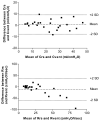Ventilator assessment of respiratory mechanics in paediatric intensive care
- PMID: 17394017
- PMCID: PMC2739298
- DOI: 10.1007/s00431-007-0477-0
Ventilator assessment of respiratory mechanics in paediatric intensive care
Abstract
Many modern "paediatric" mechanical ventilators have in-built features for estimation of respiratory mechanics which could be useful in the management of ventilated infants and children. The aim of this study was to determine if such measurements were reproducible and accurate. Ventilator (Draeger Evita 4) displayed compliance (Cvent) and resistance (Rvent) values were assessed and compared to the results of respiratory system mechanics (respiratory system compliance (Crs) and resistance (Rrs)) measurements obtained using a single breath occlusion technique. Seventeen children (median age 5.1; range 0.3 to 16 yrs) were studied on 24 occasions. The mean coefficients of variations for the techniques were similar (Cvent 13%; Crs 11%; Rvent 16%; Rrs 14%). The mean (SD) Crs (22.8 (12.3) ml/cmH2O) did not differ significantly from Cvent (22.1 (12.7) ml/cm H2O) but the mean Rrs 21.0 (12.7) cmH2O/l/s was significantly higher than the mean Rvent 32.0 (32.0) cmH2O/l/s (p = 0.03). Bland and Altman analysis demonstrated a mean difference of -10.94 cmH2O/l/s (SD 24.1) between Rrs and Rvent; the agreement between Rrs and Rvent decreased as Rrs increased (p = 0.008).
Conclusions: Ventilator assessment of compliance, but not resistance, using the Evita 4 is reproducible and reliable.
Figures
References
-
- Baumeister BL, el-Khatib M, Smith PG, Blumer JL. Evaluation of predictors of weaning from mechanical ventilation in pediatric patients. Pediatr. Pulmonol. 1997;24:344–352. - PubMed
-
- Bernstein G, Knodel E, Heldt GP. Airway leak size in neonates and autocycling of three flow-triggered ventilators. Crit. Care Med. 1995;23:1739–1744. - PubMed
-
- Bland JM, Altman DG. Statistical methods for assessing agreement between two methods of clinical measurement. Lancet. 1986;1:307–310. - PubMed
-
- Cannon ML, Cornell J, Tripp-Hamel DS, Gentile MA, Hubble CL, Meliones JN, Cheifetz IM. Tidal volumes for ventilated infants should be determined with a pneumotachometer placed at the endotracheal tube. Am J Respir Crit Care Med. 2000;162:2109–2112. - PubMed
-
- Castle RA, Dunne CJ, Mok Q, Wade AM, Stocks J. Accuracy of displayed values of tidal volume in the pediatric intensive care unit. Crit. Care Med. 2002;30:2566–2574. - PubMed
MeSH terms
Grants and funding
LinkOut - more resources
Full Text Sources


